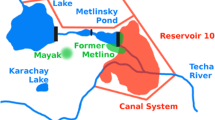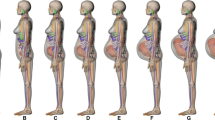Abstract
The aim of the present study was to analyze the mortality from circulatory diseases for about 30,000 members of the Techa River cohort over the period 1950–2003, and to investigate how these rates depend on radiation doses. This population received both external and internal exposures from 90Sr, 89Sr, 137Cs, and other uranium fission products as a result of waterborne releases from the Mayak nuclear facility in the Southern Urals region of the Russian Federation. The analysis included individualized estimates of the total (external plus internal) absorbed dose in muscle calculated based on the Techa River Dosimetry System 2009. The cohort-average dose to muscle tissue was 35 mGy, and the maximum dose was 510 mGy. Between 1950 and 2003, 7,595 deaths from circulatory diseases were registered among cohort members with 901,563 person years at risk. Mortality rates in the cohort were analyzed using a simple parametric excess relative risk (ERR) model. For all circulatory diseases, the estimated excess relative risk per 100 mGy with a 15-year lag period was 3.6 % with a 95 % confidence interval of 0.2–7.5 %, and for ischemic heart disease it was 5.6 % with a 95 % confidence interval of 0.1–11.9 %. A linear ERR model provided the best fit. Analyses with a lag period shorter than 15 years from the beginning of exposure did not reveal any significant risk of mortality from either all circulatory diseases or ischemic heart disease. There was no evidence of an increased mortality risk from cerebrovascular disease (p > 0.5). These results should be regarded as preliminary, since they will be updated after adjustment for smoking and alcohol consumption.
Similar content being viewed by others
References
Akleyev AV, Kisselyov MF (2002) Medical-biological and ecological impacts of radioactive contamination of the Techa River. FREGAT, Chelyabinsk
Akleyev AV, Krestinina LYu, Preston D, Davis F, Degteva MO, Anspaugh L, Startsev NV, Napier B, Ron E (2008) Radiogenic risk of malignant neoplasms for Techa riverside residents. Medical radiology and radiation safety 53(6):5–26
Azizova TV, Muirhead CR, Druzhinina MB, Grigoryeva ES, Vlasenko EV, Sumina MV, O’Hagan JA, Zhang W, Haylock RGE, Hunter N (2010) Cardiovascular diseases in the cohort of workers first employed at Mayak PA in 1948–1958. Radiat Res 174:155–168
Azizova TV, Muirhead CR, Moseeva MV, Grigoryeva ES, Sumina MV, O’Hagan JA, Zhang W, Haylock RGE, Hunter N (2011) Cerebrovascular diseases in nuclear workers first employed at the Mayak PA in 1948–1972. Radiat Environ Biophys 50:539–552
Berrington A, Darby SC, Weiss HA, Doll R (2001) 100 years of observation on British radiologists: mortality from cancer and other causes 1897–1997. Br J Radiol 74:507–519
Darby SC, Doll R, Gill SK, Smith PG (1987) Long term mortality after a single treatment course with x-rays in patients treated for ankylosing spondylitis. Br J Cancer 55:179–190
Darby SC, McGale P, Peto R, Granath F, Hall P, Ekbom A (2003) Mortality from cardiovascular disease more than 10 years after radiotherapy for breast cancer: nationwide cohort study of 90,000 Swedish women. Br Med J 326:256–257
Davis FG, Boice JD Jr, Hrubec Z, Monson RR (1989) Cancer mortality in a radiation-exposed cohort of Massachusetts tuberculosis patients. Cancer Res 49:6130–6136
Degteva MO, Vorobiova MI, Kozheurov VP, Tolstykh EI, Anspaugh LR, Napier BA (2000a) Dose reconstruction system for the exposed population living along the Techa River. Health Phys 78:542–554
Degteva MO, Kozheurov VP, Tolstykh EI, Vorobiova MI, Anspaugh LR, Napier BA, Kovtun AN (2000b) The Techa River dosimetry system: methods for the reconstruction of internal dose. Health Phys 79:24–35
Degteva MO, Tolstykh EI, Vorobiova MI, Shagina NB, Shishkina EA, Bougrov NG, Anspaugh LR, Napier BA (2006a) Techa River dosimetry system: current status and future. Radiat Saf Probl 1:66–80 (in Russian)
Degteva MO, Vorobiova MI, Tolstykh EI, Shagina NB, Shishkina EA, Anspaugh LR, Napier BA, Bougrov NG, Shved VA, Tokareva EE (2006b) Development of an improved dose reconstruction system for the Techa River population affected by the operation of the Mayak Production Association. Radiat Res 166:255–270
Degteva MO, Shagina NB, Tolstykh EI, Vorobiova MI, Anspaugh LR, Napier BA (2009) Individual dose calculations with use of the revised Techa River Dosimetry System TRDS-2009D. Chelyabinsk and Salt Lake City: Urals Research Center for Radiation Medicine and University of Utah; final report for milestone 22
Degteva MO, Shagina NB, Vorobiova MI, Anspaugh LR, Napier BA (2012) Reevaluation of waterborne releases of radioactive materials from the Mayak production association into the Techa River in 1949–1951. Health Phys 102(1):25–38
ICD-9-CM (2009) http://icd9cm.chrisendres.com/index.php?action=contents
Ivanov VK (2007) Late cancer and non cancer risks among Chernobyl emergency workers of Russia. Health Phys 93:470–479
Kossenko MM, Thomas TL, Akleyev AV, Krestinina LYu, Startsev NV, Zhidkova CM, Vyushkova OV, Hoffman DA, Preston DL, Davis F, Ron E (2005) The Techa River cohort: study design and follow-up methods. Radiat Res 164:591–601
Krestinina LYu, Preston DL, Ostroumova EV, Degteva MO, Ron E, Vyushkova OV, Startsev NV, Kossenko MM, Akleyev AV (2005) Protracted radiation exposure and cancer mortality in the Techa River cohort. Radiat Res 164:602–611
Krestinina LYu, Davis F, Ostroumova EV, Epifanova SB, Degteva MO, Preston DL, Akleyev AV (2007) Solid cancer incidence and low-dose-rate radiation exposures in the Techa River cohort: 1956–2002. Int J Epidemiol 36(5):1038–1046
Krestinina L, Preston DL, Davis FG, Epifanova S, Ostroumova E, Ron E, Akleyev A (2010) Leukemia incidence among people exposed to chronic radiation from the contaminated Techa River 1953–2005. Radiat Environ Biophys 49:195–201
Little MP, Tawn EJ, Tzoulaki I, Wakeford R, Hildebrandt G, Paris F, Tapio S, Elliot P (2010) Review and meta-analysis of epidemiological associations between low or moderate doses of ionizing radiation and circulatory disease risks, and their possible mechanisms. Radiat Environ Biophys 49(2):139–153
McGale P, Darby SC (2005) Low doses of ionizing radiation and circulatory diseases: a systematic review of the published epidemiological evidence. Radiat Res 163:247–257
McGeoghegan D, Binks K, Gillies M, Jones S, Whaley S (2008) The non-cancer mortality experience of male workers at British nuclear fuels plc 1946–2005. Int J Epidemiol 37:506–518
Preston DL, Lubin J, Pierce D, McConney M (1993) Epicure users guide. Hirosoft international company, Seattle, Washington
Preston DL, Shimizu Y, Pierce DA, Suyama A, Mabuchi K (2003) Studies of the mortality of atomic bomb survivors. Report 13: solid cancer and noncancer disease mortality: 1950–1997. Radiat Res 160(4):381–407
Report of the committee examining radiation risks of internal emitters (CERRIE) (2004) London: Crown Copyright
Shagina NB, Vorobiova MI, Degteva MO, Peremyslova LM, Shishkina EA, Anspaugh LR, Napier BA (2012) Reconstruction of the Techa River contamination in 1949-1951 as a result of releases from the “Mayak” Production Association. Radiat Environ Biophys 51(4):349–366
Shimizu Yu, Kodama K, Nishi N, Kasagi F, Suyama A, Soda M, Grant EJ, Sugiyama H, Sakata R, Moriwaki H, Hayashi M, Konda M, Shore RE (2010) Radiation exposure and circulatory disease risk: Hiroshima and Nagasaki atomic bomb survivor data 1950–2003. Br Med J 340:b5349
Tolstykh EI, Degteva MO, Vorobiova MI, Peremyslova LM, Shagina NB, Anspaugh LR, Napier BA (2006) Reconstruction of long-lived radionuclide intakes for Techa Riverside residents. Cesium-137. Radiat Saf Probl 1(Special issue):68–79 (in Russian)
Tolstykh EI, Degteva MO, Peremyslova LM, Shagina NB, Shishkina EA, Krivoshchapov VA, Anspaugh LR, Napier BA (2011) Reconstruction of long-lived radionuclide intakes for Techa Riverside residents: strontium-90. Health Phys 101(1):28–47
UNSCEAR (2006) Report Vol. 1 Effects of ionizing radiation. Annex B: Epidemiological evaluation of cardiovascular disease and other non-cancer diseases following radiation exposure. United Nations: New York
Yamada M, Wong FL, Fujiwara S, Akahoshi M, Suzuki G (2004) Non cancer disease incidence in the atomic bomb survivors 1958–1998. Radiat Res 161:622–632
Acknowledgments
This study was conducted with financial support from the European Commission in the framework of the 6th Programme Euroatom under the project “Southern Urals Radiation Risk Research (SOUL).” This work has also been supported by the US National Cancer Institute, NIH (collection of vital status information), the US Department of Energy (dosimetry study), and the Federal Medical Biological Agency of Russia (all aspects of this study). The authors would like to thank members of the Chelyabinsk Regional Center of the National Radio-Epidemiological Register (Head: Nikolai Startsev) which represents an important source of information for the URCRM core database, and professor Per Hall from the Department of Medical Epidemiology and Biostatistics of Karolinska Institute who worked with the URCRM researchers in the framework of the SOUL Project and helped to develop the design of this study.
Author information
Authors and Affiliations
Corresponding author
Rights and permissions
About this article
Cite this article
Krestinina, L.Y., Epifanova, S., Silkin, S. et al. Chronic low-dose exposure in the Techa River Cohort: risk of mortality from circulatory diseases. Radiat Environ Biophys 52, 47–57 (2013). https://doi.org/10.1007/s00411-012-0438-5
Received:
Accepted:
Published:
Issue Date:
DOI: https://doi.org/10.1007/s00411-012-0438-5




